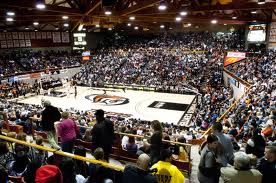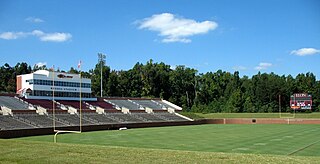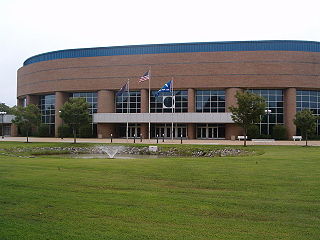
Fred C. Yager Stadium is a football stadium in Oxford, Ohio, United States. It is home to the Miami University RedHawks football team. It has a capacity of 24,286 spectators, and was built in 1983. It replaced Miami Field, which had been used since 1895 and was the home field for many of the coaches who had made the school famous. The stadium is named for Fred C. Yager, class of 1914, who was the lead benefactor in the project to build the stadium.

The Vander Veer Botanical Park is a 33-acre (130,000 m2) botanical garden in the Vander Veer Park Historic District of Davenport, Iowa. It is believed to be one of the first botanical parks west of the Mississippi River. The park was listed on the Davenport Register of Historic Properties on August 4, 1993.

Cooper Stadium was a baseball stadium in Columbus, Ohio, that was built in 1931 and closed in 2008. It was the home of several minor league teams, including the Columbus Clippers from 1977 to 2008.

Columbus Civic Center is a 10,000-seat multi-purpose arena in Columbus, Georgia, built in 1996.

The Betty Engelstad Sioux Center is an indoor arena located in Grand Forks, North Dakota. It is adjacent to the larger $100 million Ralph Engelstad Arena in the University Village development.

121 Financial Ballpark is a baseball park in Jacksonville, Florida. It is the home stadium of the Jacksonville Jumbo Shrimp Minor League Baseball team, who play in the International League. The facility opened in 2003.

Pelicans Ballpark is located in Myrtle Beach, South Carolina and is the home field of the Myrtle Beach Pelicans, a minor league affiliate of the Chicago Cubs in the Carolina League. The stadium, located just off Highway 17 in Myrtle Beach, opened in 1999. It holds up to 6,599 people. Since its opening, it has been the finish point of the annual Myrtle Beach Marathon, held annually in March.

Alex G. Spanos Center is a 6,150-seat, indoor multi-purpose stadium on the campus of the University of the Pacific in Stockton, California.

The Beeghly Physical Education Center, or simply Beeghly Center, is a 6,300-seat multi-purpose arena in Youngstown, Ohio. The arena, built at a cost of $5.5 million and named for local businessman Leon A. Beeghly, opened on December 2, 1972. It is home to the Youngstown State University Penguins basketball, volleyball, and swimming teams. The first event at the arena was a basketball game against the Ohio University Bobcats, which ended in a 68-59 Youngstown State victory.

Rhodes Stadium is an 14,000-seat multi-purpose stadium in Elon, North Carolina. Named for trustee Dusty Rhodes, his wife, Peggy, and their family, the stadium opened in 2001 and is home to the Elon University Phoenix football team. The stadium also hosts soccer games on occasion.

Hampton Convocation Center is a 7,200-seat multi-purpose arena in Hampton, Virginia. It was built in 1993 and is home to the Hampton University Pirates basketball team. The arena replaced Holland Hall gymnasium, which holds women's volleyball matches and tournaments. The construction cost was about $4 million-$5 million.

Franklin Park Conservatory and Botanical Gardens is a botanical garden and conservatory located in Columbus, Ohio. It is open daily and an admission fee is charged. Today, it is a horticultural and educational institution showcasing exotic plant collections, special exhibitions, and Dale Chihuly artworks.

Huntington Park is a baseball stadium located in Columbus, Ohio, United States. It primarily serves as the home of the Columbus Clippers of the International League, the Triple-A minor league affiliate of the Cleveland Guardians since 2009.

The Seville Expo '92 was a universal exposition that took place from Monday, April 20 to Monday, October 12, 1992, on La Isla de La Cartuja, Seville, Spain. The theme for the expo was "The Age of Discovery", celebrating the 500th anniversary of Christopher Columbus reaching the Americas after launching from Seville's port, and over 100 countries were represented. The total amount of land used for the expo was 215 hectares and the total number of visitors was 41,814,571. The exposition ran at the same time as the smaller and shorter-duration Genoa Expo '92, a Specialized Exhibition, held in memory of Christopher Columbus, born in Genoa.

Samuel W. Wolfson Baseball Park was a baseball park in Jacksonville, Florida. It stood from 1954 until 2002, when it was demolished and replaced by the new Baseball Grounds of Jacksonville. During that time it was home to all of Jacksonville's minor league baseball teams, including the Jacksonville Braves (1955–1960), the Jacksonville Jets (1961), and the Jacksonville Suns. It had a seating capacity of 8,200 and was named for local baseball owner Samuel W. Wolfson.

Value City Arena is a multi-purpose arena, located on the campus of Ohio State University, in Columbus, Ohio, United States. The arena opened in 1998 and is currently the largest by seating capacity in the Big Ten Conference, with 19,049 seats, which is reduced to 18,809 for Ohio State men's and women’s basketball games.

The Music City Center is a convention complex located in downtown Nashville, Tennessee, United States. It opened in May 2013.
Grover Center was originally built to be the home for the Ohio Bobcats men's basketball team. The first men's basketball game in the arena featured the Ohio Bobcats hosting the previous years national champion Ohio State Buckeyes on December 1, 1960 to a sold out crowd. The Ohio Bobcats basketball team only called the Grover Center home from 1960–68 after the much larger Convocation Center opened up December 3, 1968. It is named after former Bobcat coach Butch Grover.

The Alltech Arena is a 5,517-seat multi-purpose arena in Lexington, Kentucky. The facility, named for the title sponsor Alltech, opened on the grounds of the Kentucky Horse Park in July 2009. It was originally constructed for the 2010 FEI World Equestrian Games.

The Fox Cities Exhibition Center is a multi-purpose convention center located in the city of Appleton, Wisconsin in the United States. The city of Appleton owns the center and is operated by the connected Hilton Appleton Paper Valley Hotel.























